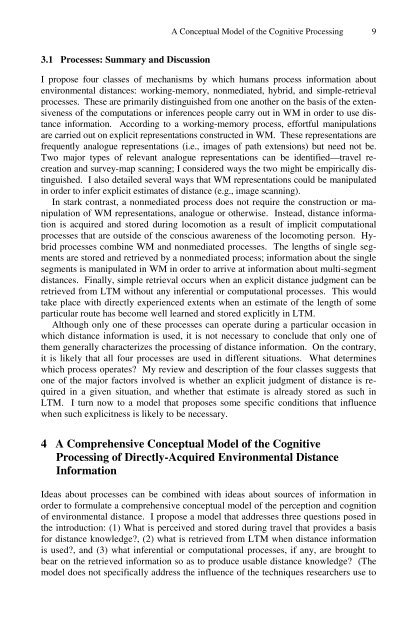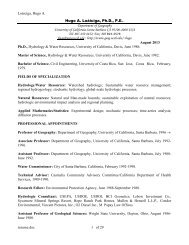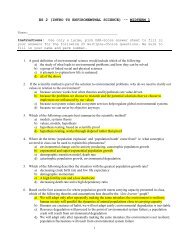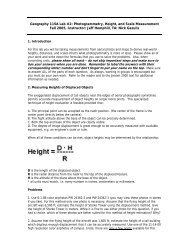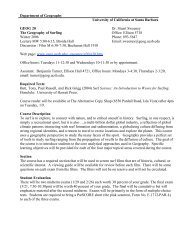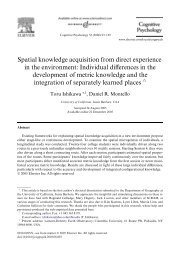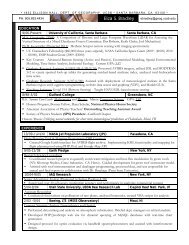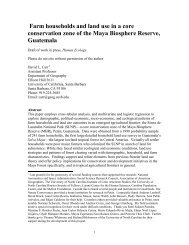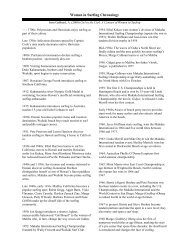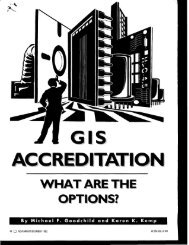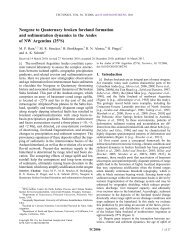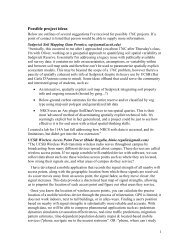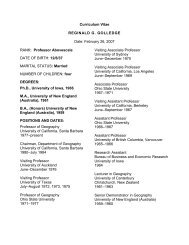A Conceptual Model of the Cognitive Processing of Environmental ...
A Conceptual Model of the Cognitive Processing of Environmental ...
A Conceptual Model of the Cognitive Processing of Environmental ...
You also want an ePaper? Increase the reach of your titles
YUMPU automatically turns print PDFs into web optimized ePapers that Google loves.
A <strong>Conceptual</strong> <strong>Model</strong> <strong>of</strong> <strong>the</strong> <strong>Cognitive</strong> <strong>Processing</strong> 9<br />
3.1 Processes: Summary and Discussion<br />
I propose four classes <strong>of</strong> mechanisms by which humans process information about<br />
environmental distances: working-memory, nonmediated, hybrid, and simple-retrieval<br />
processes. These are primarily distinguished from one ano<strong>the</strong>r on <strong>the</strong> basis <strong>of</strong> <strong>the</strong> extensiveness<br />
<strong>of</strong> <strong>the</strong> computations or inferences people carry out in WM in order to use distance<br />
information. According to a working-memory process, effortful manipulations<br />
are carried out on explicit representations constructed in WM. These representations are<br />
frequently analogue representations (i.e., images <strong>of</strong> path extensions) but need not be.<br />
Two major types <strong>of</strong> relevant analogue representations can be identified—travel recreation<br />
and survey-map scanning; I considered ways <strong>the</strong> two might be empirically distinguished.<br />
I also detailed several ways that WM representations could be manipulated<br />
in order to infer explicit estimates <strong>of</strong> distance (e.g., image scanning).<br />
In stark contrast, a nonmediated process does not require <strong>the</strong> construction or manipulation<br />
<strong>of</strong> WM representations, analogue or o<strong>the</strong>rwise. Instead, distance information<br />
is acquired and stored during locomotion as a result <strong>of</strong> implicit computational<br />
processes that are outside <strong>of</strong> <strong>the</strong> conscious awareness <strong>of</strong> <strong>the</strong> locomoting person. Hybrid<br />
processes combine WM and nonmediated processes. The lengths <strong>of</strong> single segments<br />
are stored and retrieved by a nonmediated process; information about <strong>the</strong> single<br />
segments is manipulated in WM in order to arrive at information about multi-segment<br />
distances. Finally, simple retrieval occurs when an explicit distance judgment can be<br />
retrieved from LTM without any inferential or computational processes. This would<br />
take place with directly experienced extents when an estimate <strong>of</strong> <strong>the</strong> length <strong>of</strong> some<br />
particular route has become well learned and stored explicitly in LTM.<br />
Although only one <strong>of</strong> <strong>the</strong>se processes can operate during a particular occasion in<br />
which distance information is used, it is not necessary to conclude that only one <strong>of</strong><br />
<strong>the</strong>m generally characterizes <strong>the</strong> processing <strong>of</strong> distance information. On <strong>the</strong> contrary,<br />
it is likely that all four processes are used in different situations. What determines<br />
which process operates? My review and description <strong>of</strong> <strong>the</strong> four classes suggests that<br />
one <strong>of</strong> <strong>the</strong> major factors involved is whe<strong>the</strong>r an explicit judgment <strong>of</strong> distance is required<br />
in a given situation, and whe<strong>the</strong>r that estimate is already stored as such in<br />
LTM. I turn now to a model that proposes some specific conditions that influence<br />
when such explicitness is likely to be necessary.<br />
4 A Comprehensive <strong>Conceptual</strong> <strong>Model</strong> <strong>of</strong> <strong>the</strong> <strong>Cognitive</strong><br />
<strong>Processing</strong> <strong>of</strong> Directly-Acquired <strong>Environmental</strong> Distance<br />
Information<br />
Ideas about processes can be combined with ideas about sources <strong>of</strong> information in<br />
order to formulate a comprehensive conceptual model <strong>of</strong> <strong>the</strong> perception and cognition<br />
<strong>of</strong> environmental distance. I propose a model that addresses three questions posed in<br />
<strong>the</strong> introduction: (1) What is perceived and stored during travel that provides a basis<br />
for distance knowledge?, (2) what is retrieved from LTM when distance information<br />
is used?, and (3) what inferential or computational processes, if any, are brought to<br />
bear on <strong>the</strong> retrieved information so as to produce usable distance knowledge? (The<br />
model does not specifically address <strong>the</strong> influence <strong>of</strong> <strong>the</strong> techniques researchers use to


